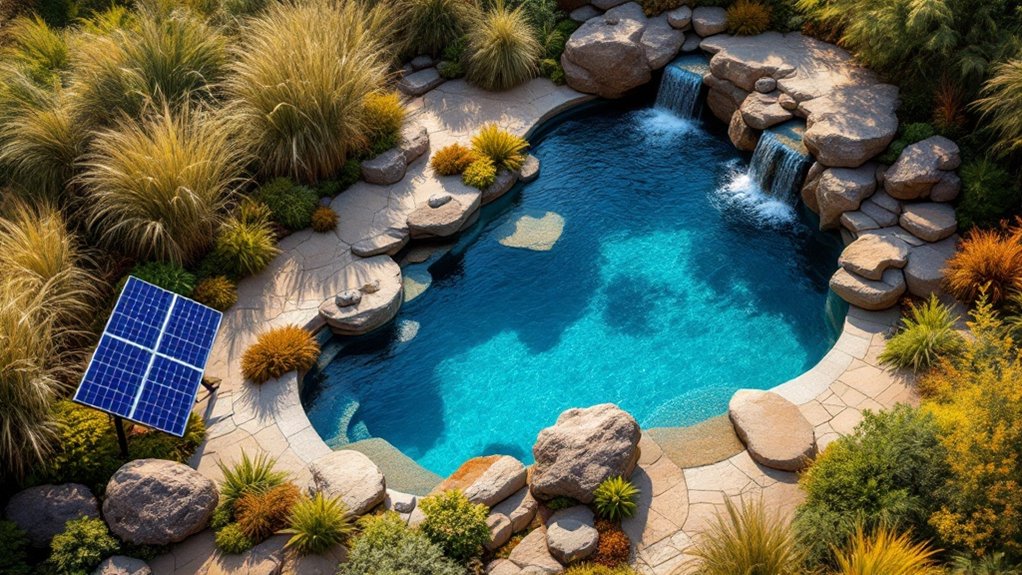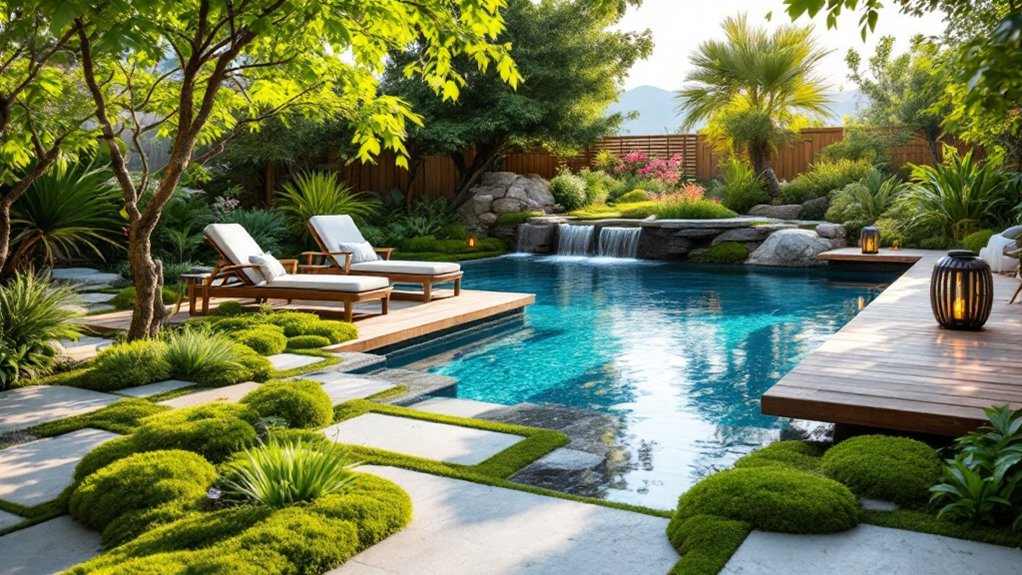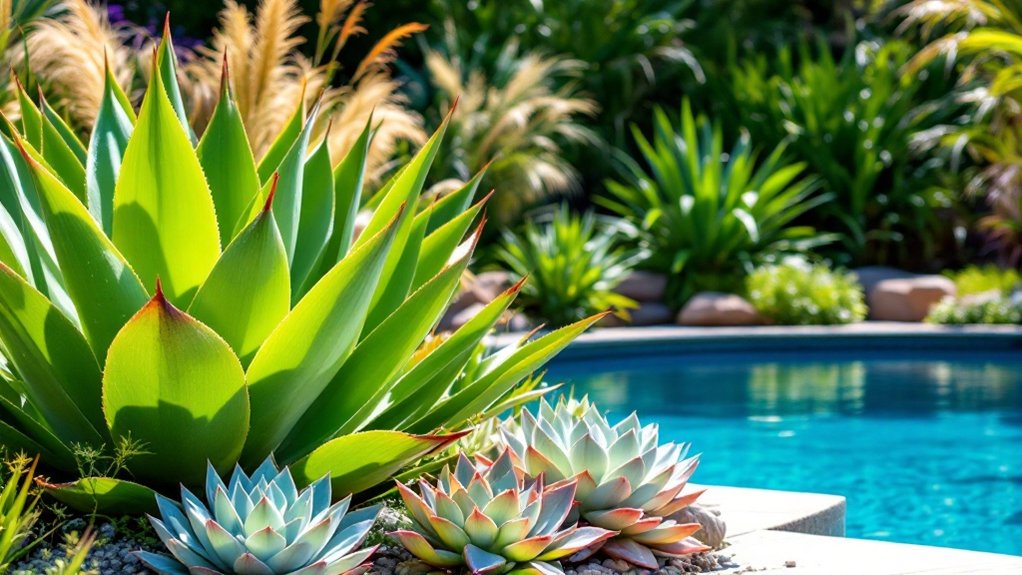Creating a stunning sustainable pool design involves careful consideration of various elements. It requires an understanding of eco-friendly materials, energy-efficient systems, and natural landscaping. Each choice contributes to a harmonious blend with the environment. By focusing on sustainability, one can enhance both aesthetic appeal and functionality. The journey to an eco-conscious pool design is intricate, prompting a closer look at the principles that guide this innovative approach. What techniques will prove most effective?
Understanding Sustainable Pool Design Principles
How can one create a pool that harmonizes with the environment while providing enjoyment? Sustainable pool design principles focus on integrating natural elements and minimizing environmental impact. This involves selecting an appropriate location that takes advantage of natural sunlight and wind patterns, thereby reducing energy consumption. A well-planned layout can incorporate native landscaping, reducing the need for excessive water and maintenance. Additionally, the design should consider water conservation methods, such as rainwater harvesting and efficient filtration systems. Incorporating natural swimming features, such as plants that filter water, enhances the aesthetic appeal while supporting local ecosystems. Ultimately, sustainable pool design emphasizes harmony between human enjoyment and environmental preservation, creating a serene retreat that aligns with the surrounding landscape.
Choosing Eco-Friendly Materials
Incorporating eco-friendly materials is a fundamental aspect of sustainable pool design that complements the principles of environmental harmony discussed earlier. Selecting materials such as recycled glass tiles, natural stone, and sustainably sourced wood greatly reduces the environmental impact of pool construction. These options not only enhance aesthetic appeal but also promote durability, reducing the need for frequent replacements. Additionally, non-toxic sealants and finishes should be prioritized to minimize harmful chemicals that can leach into the environment. Furthermore, using permeable paving materials for surrounding areas can help manage water runoff effectively. By choosing these eco-friendly materials, pool designers can create spaces that are both beautiful and responsible, ensuring a lasting contribution to environmental sustainability.
Implementing Energy-Efficient Heating Solutions
While traditional pool heating solutions can greatly increase energy consumption, implementing energy-efficient heating technologies can substantially reduce both environmental impact and operating costs. One popular option is the use of heat pumps, which transfer heat from the air or ground to warm the pool water, consuming considerably less energy than conventional gas heaters. Solar heating systems are another sustainable choice, harnessing sunlight to maintain ideal water temperatures without reliance on fossil fuels. Additionally, investing in pool covers can minimize heat loss, further enhancing energy efficiency. By combining these methods, pool owners can create a more sustainable and cost-effective heating strategy, ensuring a comfortable swimming experience while contributing to environmental preservation. Embracing these solutions marks a notable step toward eco-friendly pool management. Modern gas pool heaters, when installed by professionals, also offer reliable performance and can be part of an energy-efficient heating solution.
Utilizing Natural Filtration Systems
Natural filtration systems offer an eco-friendly alternative to traditional pool cleaning methods, providing benefits such as reduced chemical use and enhanced water clarity. These systems can vary from constructed wetlands to biofilters, each with unique advantages. Proper maintenance and care are essential to guarantee these systems operate effectively and sustainably.
Benefits of Natural Filtration
As homeowners increasingly seek eco-friendly alternatives, the benefits of utilizing natural filtration systems for pools become more apparent. These systems leverage natural processes to maintain water clarity and quality, markedly reducing the need for harsh chemicals. By using plants and microorganisms, natural filtration promotes a balanced ecosystem, enhancing biodiversity in pool environments. Additionally, these systems often require less energy compared to traditional filtration methods, leading to lower operational costs and a reduced carbon footprint. The aesthetic appeal of natural pools, with their organic design and integration into landscapes, offers a serene swimming experience. Ultimately, natural filtration systems align with sustainable practices, appealing to environmentally conscious homeowners looking to create an inviting and responsible outdoor oasis.
Types of Natural Systems
The growing popularity of natural filtration systems has led to various innovative designs that cater to different preferences and landscapes. Among these, the constructed wetland system mimics natural ecosystems, utilizing plants and microorganisms to filter water effectively. Another option is the biofiltration system, which employs layers of gravel, sand, and organic materials to purify water. Additionally, some designs incorporate aquatic plants directly into the pool’s structure, creating a seamless integration of swimming and nature. The integration of mechanical systems, such as pumps and skimmers, can enhance these natural approaches while maintaining aesthetic appeal. Ultimately, choosing the right type of natural system depends on factors like climate, available space, and the desired balance between natural beauty and functionality.
Maintenance and Care Tips
While enjoying the benefits of a natural filtration system, regular maintenance is essential to guarantee peak performance and water quality. Routine inspections of plant health and balance are vital, as dead or decaying vegetation can compromise filtration efficiency. Regularly remove debris, such as leaves and organic matter, to prevent clogging and to maintain clear water. Additionally, monitoring water levels and adjusting them as necessary helps secure ideal filtration flow. It is also important to test water quality periodically, checking for pH, alkalinity, and nutrient levels. Implementing a regular cleaning schedule for the filtration media will enhance the system’s effectiveness. Finally, addressing any signs of algae growth promptly will help maintain a healthy and beautiful swimming environment.
Incorporating Water Conservation Techniques
Incorporating water conservation techniques into pool design not only enhances sustainability but also promotes responsible usage of this precious resource. Key strategies include the installation of water-efficient filtration systems that minimize waste and the use of variable speed pumps, which reduce energy consumption and lower water turnover rates. Additionally, utilizing a pool cover can greatly decrease evaporation, retaining water while keeping it clean and warm. Rainwater harvesting systems can also be integrated, allowing for the collection and use of rainwater for pool filling and maintenance. In addition, drought-resistant landscaping surrounding the pool can reduce the need for excessive watering, creating a harmonious balance between pool aesthetics and environmental stewardship. These approaches collectively contribute to a more sustainable and eco-friendly swimming experience. Furthermore, regular pipe cleaning is essential to ensure efficient water circulation and prevent clogs, which can save both water and energy in the long run.
Designing for Optimal Sunlight Exposure
Effective pool design requires careful consideration of solar orientation strategies to maximize natural sunlight exposure. Additionally, integrating shade considerations and understanding seasonal sun angles can enhance the pool’s usability throughout the year. By prioritizing these elements, designers can create a harmonious balance between sunlight and shade, promoting both comfort and energy efficiency.
Solar Orientation Strategies
When designing a sustainable pool, understanding solar orientation is vital for maximizing sunlight exposure throughout the day. A well-planned orientation allows for ideal heating of the water, reducing energy costs and enhancing user comfort. Ideally, pools should be positioned to capture the sun’s rays from morning to evening, typically facing south or southwest in northern hemispheres. This strategic placement guarantees that the pool receives direct sunlight for the longest duration. Additionally, incorporating angled surfaces or reflective materials can further boost sunlight penetration. Consideration of local climate and seasonal variations also plays a significant role in determining the best orientation. By prioritizing solar orientation, pool designers can create a sustainable oasis that aligns with environmental goals and promotes energy efficiency.
Shade Considerations
Shade plays an essential role in the overall design of a sustainable pool, balancing the need for sunlight exposure with the comfort of users. Incorporating shade elements, such as trees, pergolas, or shade sails, can greatly enhance the pool experience by providing relief from intense heat and harmful UV rays. Strategic placement of these features guarantees that areas remain cool while still allowing for sunlit zones conducive to swimming and relaxation. Designers must consider the layout and orientation of the pool to optimize both shaded and sunlit areas throughout the day. Additionally, using sustainable materials for shade structures can further enhance the eco-friendliness of the overall design, promoting a harmonious relationship between nature and leisure.
Seasonal Sun Angles
Understanding seasonal sun angles is essential for maximizing sunlight exposure in a sustainable pool design. By analyzing the sun’s position throughout the year, designers can strategically orient the pool to capture ideal sunlight during different seasons. This involves considering the sun’s path, which varies with latitude and time of year. For instance, during summer months, higher sun angles allow for prolonged direct sunlight, while winter months necessitate lower angles for effective solar gain. Additionally, incorporating features like overhangs or pergolas can provide shade when needed, balancing comfort and energy efficiency. By thoughtfully planning the layout according to these seasonal variations, homeowners can guarantee a pool that remains inviting and functional year-round, promoting eco-friendly practices while enhancing outdoor enjoyment.
Enhancing Aesthetics With Native Landscaping
Native landscaping serves as an essential component in enhancing the aesthetics of sustainable pool designs. By incorporating local flora, homeowners can create a harmonious relationship between the pool area and the surrounding environment. Native plants typically require less water and maintenance, making them an eco-friendly choice that aligns with sustainability goals. Additionally, these plants attract local wildlife, adding vibrancy and life to the space. The natural colors and textures of native vegetation can soften the hard edges of pool structures, while creating visually appealing focal points. Strategically placed shrubs, flowers, and grasses can also provide privacy and shade, enhancing the overall experience. Ultimately, native landscaping transforms a pool area into a serene oasis that celebrates the region’s ecological heritage.
Exploring Solar Pool Cover Options
As homeowners seek to enhance the sustainability of their pools, exploring solar pool cover options becomes increasingly important. These covers serve multiple purposes, primarily focusing on energy efficiency. By harnessing solar energy, they help maintain water temperature, reducing the need for heating systems and lowering energy costs. Various types of solar pool covers are available, including bubble covers that trap heat and solar blankets that offer additional insulation. Additionally, some options are designed to be lightweight and easy to handle, making them convenient for everyday use. Homeowners can also find covers in different sizes and materials, ensuring a perfect fit for their pool while contributing to long-term sustainability efforts. Overall, solar pool covers represent a practical investment in eco-friendly pool management.
Maintenance Tips for Sustainable Pools
While maintaining a sustainable pool may seem challenging, implementing effective maintenance practices can greatly enhance its eco-friendliness and longevity. Regularly checking and balancing water chemistry helps prevent excessive chemical use, while utilizing natural alternatives can further minimize environmental impact. Routine cleaning with eco-friendly tools, such as leaf skimmers and biodegradable cleaners, guarantees a clean pool without harsh chemicals. Additionally, checking filters and pump efficiency can reduce energy consumption. Adopting a seasonal maintenance schedule aids in early detection of issues, preventing costly repairs. Incorporating plants around the pool can assist with natural filtration and provide shade. Ultimately, these strategies contribute not only to a healthier pool but also to a more sustainable lifestyle. Furthermore, regular equipment inspections can help identify wear and tear, ensuring that your pool remains in optimal condition.
Frequently Asked Questions
What Are the Costs Associated With Building a Sustainable Pool?
The costs associated with building a sustainable pool vary considerably. Factors include materials, energy-efficient systems, landscaping, and water management features. Ultimately, investing in sustainability may lead to long-term savings and environmental benefits.
How Long Does It Take to Construct a Sustainable Pool?
The construction time for a sustainable pool varies, typically ranging from six weeks to several months. Factors influencing this duration include design complexity, site conditions, and availability of eco-friendly materials and skilled labor.
Can I Retrofit an Existing Pool to Be More Sustainable?
Retrofitting an existing pool for sustainability is possible. Homeowners can upgrade filtration systems, install energy-efficient pumps, and incorporate solar heating, enhancing water conservation and reducing environmental impact while improving overall pool efficiency and enjoyment.
What Permits Are Required for a Sustainable Pool Installation?
The requirements for permits in sustainable pool installation vary by location. Typically, permits may involve zoning, environmental assessments, and safety regulations, ensuring compliance with local laws and standards for sustainable construction and water usage.
How Can I Ensure My Sustainable Pool Complies With Local Regulations?
To guarantee compliance with local regulations, one must research specific zoning laws, building codes, and environmental guidelines. Consulting with local authorities or a qualified professional can help navigate the complexities of sustainable pool installation requirements.
Conclusion
To summarize, a stunning sustainable pool design not only enhances aesthetics but also promotes environmental responsibility. By integrating eco-friendly materials, energy-efficient heating solutions, and natural filtration systems, pool owners can create an inviting space that minimizes ecological impact. Thoughtful landscaping and water conservation techniques further guarantee harmony with the surrounding environment. Ultimately, a well-designed sustainable pool serves as a revitalizing oasis while contributing positively to the ecosystem, making it a valuable addition to any property.




